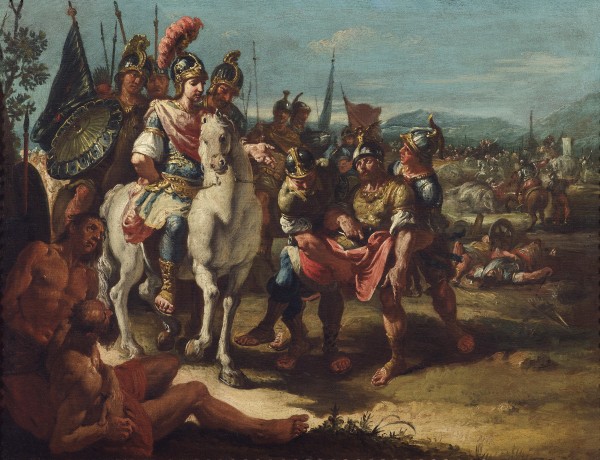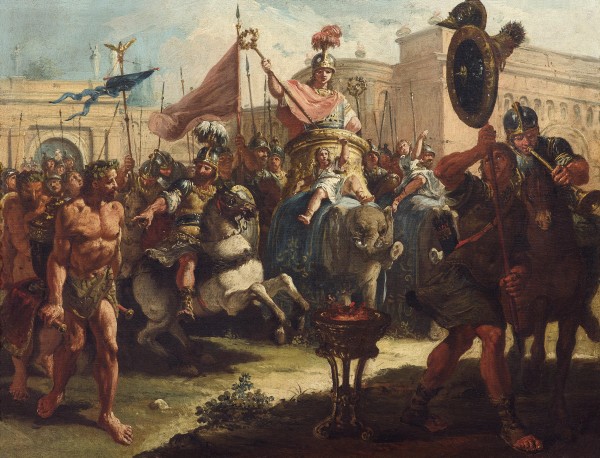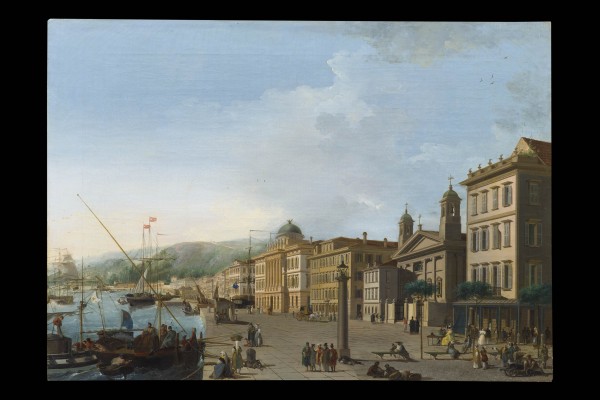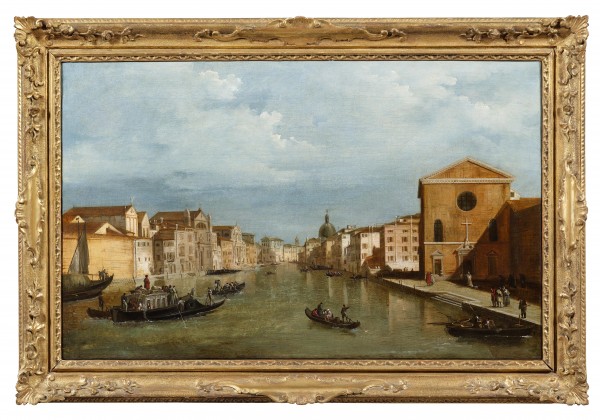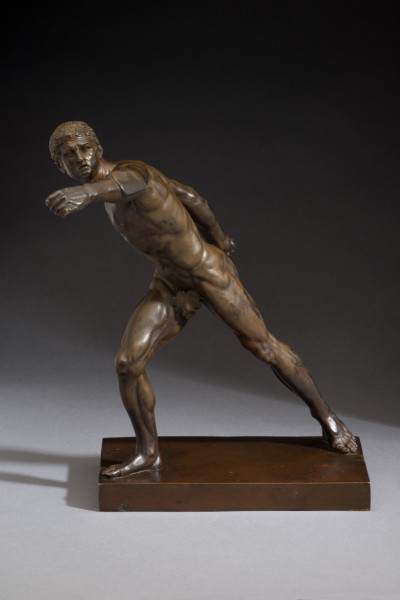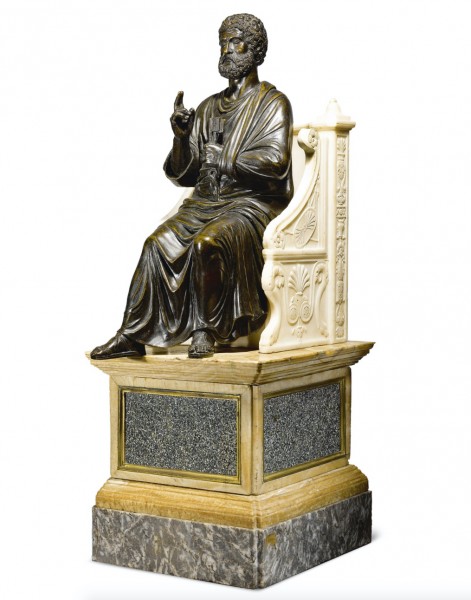Francesco Fontebasso
Venezia 1707 - 1769The clemency of Alexander the Great
Oil on Canvas 56 x 72,5
Francesco Fontebasso is one of the protagonists of the extraordinary painting season of the Venetian eighteenth century: he is one of those "traveling painters" who - from Ricci to Pellegrini, from Rosalba to Tiepolo, from Canaletto to Bellotto - once again art of the city a European role. Very active cooler, skilled decorator, excellent painter, he ranges from everyday life scenes to devotional paintings, from historical representations to portraits, also demonstrating great skills and mastery of the most diverse techniques in graphics.
Fontebasso's training takes place in Sebastiano Ricci's workshop, a stable reference throughout his career, continuing then in Rome at the Academy of San Luca (1728) and in Bologna. Traces of these phases remain in the classical imprint, in the full-bodied plasticism and in the perspective-architectural structures of the Emilian quadraturistic tradition that will remain constant in its production. Back in Venice, he lets himself be conquered by the impetuous air and the violent chiaroscuro effects of the young Giambattista Tiepolo. He begins by working on religious themes for the Manins, first in the chapel of the Villa di Passariano (1732) and then in Venice in the Jesuit church, where he creates two compartments in the ceiling with Elijah kidnapped in heaven and The angels appear to Abraham (1734), in whose influence from Tiepolo is evident. In the spring of 1736, shortly after his wedding with Angela Maria Belli, he received the first important commission outside Venice, for fresco decorations in the church of SS. Annunziata in Trento. The lively lunette with The Apotheosis of Venice, exhibited here in Ca 'Rezzonico (in the small room - adjacent to this one where the exhibition is set up - which leads to the rooms dedicated to the frescoes by Giandomenico Tiepolo from the villa di Zianigo), where the Serenissima is depicted as an elegant richly dressed lady bowing to the Virgin and Child and to San Marco.
After about twenty years, in 1759, he will get another important assignment in Trento for 19 canvases inspired by the Old and New Testament for the great hall and the refectory of the Buon Consiglio Castle. But the happiest moment in Fontebasso's career is that of the great decoration, when, around the middle of the century, he becomes, thanks also to the distance or the unavailability of Tiepolo, one of the most requested painters by the Venetian nobility, in a period of great ferment. decorative that seems to want to contrast the sunset of the Serenissima. For Francesco, the commissions follow one another at a fast pace: the Duodos, the Bernards, the Boldus, the Barbarigos, the Contarini turn to him to stage joyful compositions on the ceilings of their homes and in the country villas. in St. Petersburg, where Francis is called in the spring of 1761 by the Empress Elizabeth to decorate the ceiling of the church of the Winter Palace. With the trip to Russia the artistically happiest period of the artist's activity ends, even if, on his return, official recognitions, such as the election to the Presidency of the Academy (1768), consecrate him among the leaders of the Venetian school . The production of the last few years has, in fact, more polished forms, as in the series of four canvases of the church of San Francesco della Vigna (1765) in which there is a stylistic stiffening aimed at images of cold elegance, far from the previous palpitating creations and tangible concreteness.
The painting studied here refers to a version with variants of the same subject kept at the Guglielmo da Saliceto hospital in Piacenza.
The attribution to Fontebasso is due to Eugenio Riccomini (see Ceschi Lavagetto, 1981, p. 51).
Francesco Fontebasso
Venezia 1707 - 1769The trionfal entry of Alexander the Great in Babylon
Oil on Canvas 56 x 72,5
Francesco Fontebasso is one of the protagonists of the extraordinary painting season of the Venetian eighteenth century: he is one of those "traveling painters" who - from Ricci to Pellegrini, from Rosalba to Tiepolo, from Canaletto to Bellotto - once again art of the city a European role. Very active cooler, skilled decorator, excellent painter, he ranges from everyday life scenes to devotional paintings, from historical representations to portraits, also demonstrating great skills and mastery of the most diverse techniques in graphics.
Fontebasso's training takes place in Sebastiano Ricci's workshop, a stable reference throughout his career, continuing then in Rome at the Academy of San Luca (1728) and in Bologna. Traces of these phases remain in the classical imprint, in the full-bodied plasticism and in the perspective-architectural structures of the Emilian quadraturistic tradition that will remain constant in its production. Back in Venice, he lets himself be conquered by the impetuous air and the violent chiaroscuro effects of the young Giambattista Tiepolo. He begins by working on religious themes for the Manins, first in the chapel of the Villa di Passariano (1732) and then in Venice in the Jesuit church, where he creates two compartments in the ceiling with Elijah kidnapped in heaven and The angels appear to Abraham (1734), in whose influence from Tiepolo is evident. In the spring of 1736, shortly after his wedding with Angela Maria Belli, he received the first important commission outside Venice, for fresco decorations in the church of SS. Annunziata in Trento. The lively lunette with The Apotheosis of Venice, exhibited here in Ca 'Rezzonico (in the small room - adjacent to this one where the exhibition is set up - which leads to the rooms dedicated to the frescoes by Giandomenico Tiepolo from the villa di Zianigo), where the Serenissima is depicted as an elegant richly dressed lady bowing to the Virgin and Child and to San Marco.
After about twenty years, in 1759, he will get another important assignment in Trento for 19 canvases inspired by the Old and New Testament for the great hall and the refectory of the Buon Consiglio Castle. But the happiest moment in Fontebasso's career is that of the great decoration, when, around the middle of the century, he becomes, thanks also to the distance or the unavailability of Tiepolo, one of the most requested painters by the Venetian nobility, in a period of great ferment. decorative that seems to want to contrast the sunset of the Serenissima. For Francesco, the commissions follow one another at a fast pace: the Duodos, the Bernards, the Boldus, the Barbarigos, the Contarini turn to him to stage joyful compositions on the ceilings of their homes and in the country villas. in St. Petersburg, where Francis is called in the spring of 1761 by the Empress Elizabeth to decorate the ceiling of the church of the Winter Palace. With the trip to Russia the artistically happiest period of the artist's activity ends, even if, on his return, official recognitions, such as the election to the Presidency of the Academy (1768), consecrate him among the leaders of the Venetian school . The production of the last few years has, in fact, more polished forms, as in the series of four canvases of the church of San Francesco della Vigna (1765) in which there is a stylistic stiffening aimed at images of cold elegance, far from the previous palpitating creations and tangible concreteness.
Attributed to John Gibson RA
Conway 1790 - Rome 1866Narcissus
Terracotta
Cm 45 x 68 x 38
John Gibson RA is best known for his exquisite depictions of figures from classica mythology, working in the neoclassical tradition of Antonio Canova (1757 – 1822) and Berthel Thorvaldsen (1770 – 1844), in Rome. He was perhaps the leading British sculptor of the nineteenth century and enjoyed the patronage of high-profile clients including: Queen Victoria of Great Britain, the Duke of Devonshire, Count Erwein of Schönborn, Alessandro Torlonia and Tsar Nicholas I of Russia. In 1833 Gibson was elected Associate of the Royal Academy in London and five years later was sworn in as a full member, exhibiting there between 1816 and 1864. He had an illustrious artistic career and received many international honours, including the Légion d'Honneur, which was awarded to him by the French government in 1864.
John Gibson arrived in Rome on 20th October 1817, aged 27, with four letters of recommendation from Sir George D’Aguilar, Henry Fuseli (1741 – 1825), John Flaxman (1755 – 1826) and from Lord Brougham. The impact the ‘Eternal City’ had on the ambitious young sculptor cannot be overstated. For at this time, it was the centre of the contemporary and classical art world and had an unrivalled abundance of ancient masterpieces, which sculptors could copy and take direct inspiration from, on a daily basis. Gibson once famously declared: “I thank God for every morning that opens my eyes in Rome” and indeed, he remained a resident of the city his whole life, leaving only for important commissions (for example, to carve his two portrait statues of Queen Victoria in 1844 and 1850) and during the revolutionary events of 1847-1849, during which time he moved to Lucca.
In addition to the antiquities of Rome, one of the greatest artistic influences on Gibson was Antonio Canova, who was celebrated as Europe’s leading artist and regarded as the ‘Phidias of his time’. During his education in Canova’s bustling studio between 1817 and 1822, he had the opportunity to work in clay. He would have observed the practice of Canova making small terracotta models, or bozzetti, which were then worked up into a full-scale clay model, to be finally cast in plaster and enlarged by his studio assistants for translation into marble, using a curious contraption known as a ‘pointing machine’. There exists a fascinating account of the young John Gibson learning to work with clay in Canova’s studio, under the watchful eye of his main assistant Antonio D’Este:
“At my own request Canova allowed me to copy his fine Pugilist – the marble statue in the Vatican. I began with great zeal to model my copy from the cast in the studio. After I had worked at the clay for a few days, down it all fell! It seems that my master had observed to his foreman, Signor Desti (Antonio D’Este), that my figure must fall, ‘for you see’, said he, ‘that he knows nothing of the skeleton work – but let him proceed, and when his figure comes down, show him how the mechanical part is done.’ So when the model fell, a blacksmith was called in, and the iron work was made, with numerous crosses of wood and wire.” Gibson also perhaps learned a great deal about the art of clay modelling during a brief time working under Joseph Nollekens, who is famed for the bravura of his terracotta ‘pensieri’ – as he referred to them. Indeed, a model of Theseus and the centaur by Gibson was included in the sale of Nolleken’s effects at Christies in 1823.
Canova was a huge influence on Gibson during his early years in Rome. Not only did he support him with artistic and technical advice, but he also assisted in establishing the framework for the young sculptor’s career. Gibson was affectionately called the ‘British Canova’ by many and referred to himself as ‘Canova’s last pupil’ in a letter to Antonio Gacini, Secretary of the Royal Academy in Milan in 1861: “The first instruction which I received in my art was from an Italian. It was Canova whose pupil I became in the year 1817 and studied under him for five years when he died. I was his last pupil.”
However, Gibson was no mere copyist. His work is markedly distinct from the great Italian’s and has a softer, perhaps more human quality. John Gibson was one of the few remaining exponents of the ‘pure’ neoclassical style of sculpture, who sought to achieve ‘ideal’ classical forms, while on the whole, his contemporaries and rivals were pursuing notions of formal naturalism, or ‘verismo’, such as depicting modern subjects wearing the contemporary fashions of the day.
Inspired by the writings of Johann Joachim Winckelmann (1717 – 1768), Gibson aimed to achieve ‘the sublime and the purest beauty’ in his sculpture through study of the human form perfected to the standards of classical sculpture. The strong influence of the antique can be seen in the composition of the present work. The inspiration for the general form of this terracotta Narcissus was perhaps taken from the Capitoline Gaul or Dying Gladiator (fig.1), while the Centocelle Eros of the Vatican (fig.2) could have provided a model for the downward tilting attitude of the head and the thick curls of shoulder-length hair.
By 1821, Gibson had established his own studio in the Via Fontanella, just off the artistic hub of the via Babuino. The first major work of his own conception was his Sleeping Shepherd Boy from 1824 (fig.3), made for Lord George Cavendish. Gibson reinterpreted this theme a number of times, making other versions for the Duke of Northumberland and a Mr Lenox of New York. This terracotta Narcissus is depicted in a similarly languid pose and adopts a comparably relaxed countenance. Their heavy heads are bowed, both in drowsy dream-states, full unconscious slumber in the case of the Shepherd Boy, while Narcissus is caught in a trance-like day-dream, as he stares into the water below, enamoured with the beautiful appearance of his own reflection. Their torsos are also gently ‘crunched’, with their abdominal muscles engaged in a similar contorsion (fig.4). Anatomically perfect, both models demonstrate the education Gibson received, not just from studying the ancient models which of course abounded in his adopted city, but the anatomy classes he attended in Britain, led by Dr Vose, who dissected human corpses for his students.
In 1830 Gibson is known to have made a Narcissus in marble for Lord Barrington and subsequently made two others for a Mr Evrington and a Mr Fort of Manchester. He returned to the theme again, sending a Narcissus to the Royal Academy as a submission for his diploma work in 1838 (fig.5). In Ovid’s version of the story of Narcissus and Echo in his Metamorphosis, the nymph Echo fell in love with a beautiful young hunter called Narcissus. But her love was not returned and Echo was condemned by the goddess Juno to repeat only the last words that were spoken to her. As a punishment for spurning Echo’s love, Narcissus was made to fall in love with his own reflection and expired gazing at himself in a pool of water. In his place a flower grew and which took on his name. It is a tragic tale and one of the most famous surviving from antiquity and so would have been an enticing subject for Gibson. The inspiration for the Royal Academy’s example was apparently the sight of a boy sitting on the edge of a fountain that Gibson noticed during a morning walk along the Monte Pinciano, thus satisfyingly combining an observed genre scene with a well-known classical allegory.
The handling of the head and facial details of the terracotta Narcissus appears to be very similar to the marble work of the same subject that Gibson sent to the Royal Academy in 1838 (fig.6 and 6a) and also his Cupid disguised as a Shepherd Boy at Yale (fig.7). Specifically, their slim, pointed noses, their small, plump, slightly parted lips and their heavy-lidded, blank, pupil-less eyes – in the manner of the ancients. The clay figure’s remarkable head of deep, shoulder-length curls also has much in common with those carved by Gibson for his marble Narcissus, but also to his Love tormenting the soul, at the Walker Art Gallery, Liverpool. It is also interesting to compare the positioning, modelling and anatomical style of the hands and feet of the terracotta model to the marble Narcissus and the Sleeping Shepherd Boy, respectively - for their smooth, yet pronounced, squared-off knuckles and deeply incised nails must surely have been made by the same master.
When one compares the physiognomic details of this newly discovered terracotta with other major works from Gibson’s oeuvre, the comparisons are so striking that it seems almost certain that the present terracotta is by the hand of John Gibson. The model therefore represents an important art historical discovery for scholars and collectors of European neoclassical sculpture: it adds another model to Gibson’s oeuvre, revealing a different conception of the subject of Narcissus based on ancient archetypes available to Gibson in Rome. In conjunction with this, it also expands our understanding of the types of media that he used in his own artistic practice and increases our appreciation of the skill and facility he had in modelling clay.
Giuseppe Bernardino Bison
Palmanova 1762 – Milan 1844Trieste, The Molo towards Palazzo Carciotti
Oil on canvas
Cm 53,5 x 64,5
Giuseppe Bernardino Bison was born on June 16, 1762 in Palmanova, the youngest of four children, to Giovanni Battista, a native of Castelfranco, and Angelina Granelli from Venice, who arrived in the Friulian town to devote themselves to the processing of wool. The family soon moved to Brescia and it was there that - according to Giovanni Rossi, the artist's first biographer - the young B. showed a very precocious predisposition to drawing, so much so as to convince his parents to start him on artistic studies with painters. Girolamo Romani and Saverio Gandini, the latter specializing in perspective painting. At the end of the seventies of the century another transfer followed, this time to Venice where, at the interest of the modest decorator Giovanni Antonio Zanetti, B. took up the lessons of Costantino Cedini, professor of figure at the Academy, a Tiepolo follower, and of Antonio Mauro, set designer and painter of perspectives. It was among the benches of the Academy at Fonteghetto della Farina that the Friulian-born painter probably also came into contact with Francesco Guardi, an academic teacher since 1784. His first training therefore took place under the banner of a strictly observant tiepolism, barely veiled in classicist suggestions, combined with an interest in scenography and the easy and "capricious" repertoire of Venetian landscape painting of the late eighteenth century. In 1787, making use of his personal acquaintance relationships with the architect Giannantonio Selva, he was called by the latter to collaborate in the decoration of an apartment in Domenico Bottoni's palace in Ferrara (lost paintings). In the same year the presence of B. is also recorded in Padua for the ornamentation works of the Teatro Nuovo alongside his teacher Antonio Mauro; the contacts with the Marquis Tommaso degli Obizzi initiated on that occasion allowed him, after finishing his academic studies in 1789, to intervene between April and November 1790 in the Catajo castle with unspecified works, but documented by precise payment notes , which must have had a greater consistency than the five still existing chimney covers. Also in Padua, in 1792, B. was called to create some frescoes in Palazzo Maffetti (now Manzoni), to move, in August 1793, to Treviso, leaving numerous traces of his presence on the territory.
In fact, he worked on the frescoes at Villa Spineda in Breda di Piave, at Villa Formerly Tivaroni in Lancenigo (1794 ca.), in the parish church of Venegazzù (1794-1795) where he completed a depiction of the Martyrdom of Saint Andrew on the ceiling , in the oratory of Villa Bragadin in Ceggia (1795; today in the province of Venice) and finally, through the intercession of his friend Selva, at the Casino Soderini (1796). The ornamental cycles performed in this period of time highlight the artist's attempt to reach a compromise between the still dominant tradition of Tiepolo and the neoclassical poetics in a nutshell that began to penetrate even in the Veneto area. If in 1800 some documents testify the intervention of B. for some decorations carried out in Palazzo Dolfin Manin in Venice, a city where he had also worked in the following of Cedini in other buildings (palazzi Giustiniani Recanati alle Zattere, Bellavite in San Maurizio and Querini Stampalia ), it cannot be excluded that he had already moved to Trieste probably prompted by Selva who would have wanted him next to him for the construction works of the New Theater (now Verdi), if these had not then been entrusted to Matteo Pertsch who completed in 1801. That was the occasion that pushed B. to settle in the Julian capital with a prolonged stay which ended only in 1831, following the definitive move to Milan. The contacts, initiated in the city with the powerful "enclave" of the rich merchant bourgeoisie, led him to execute, in 1803, the cycle of frescoes in the round room of the building that the Greek merchant Demetrio Carciotti had built on the banks. These are eight episodes of the Iliad (Venus taking Paris out of the fight, Sinone before Priam, The death of Patroclus, The abduction of Helen, The sacrifice of Polyxena, Duel of Paris and Menelaus, The body of Hector dragged by the chariot of Achille, The marriage of Paride and Elena) which demonstrate their creator personally tuned to the achievements imposed by the now dominant neoclassical poetics also in the Trieste area.
Subsequently, between 1805 and 1806, B. was called to work as a decorator in the building of the new Stock Exchange erected by Antonio Mollari, where in the hall he portrayed Charles VI grants to Trieste the port exemptions to celebrate the imperial act that he had secured, in 1719, the commercial fortunes of Trieste. Unfortunately, today no trace is preserved of other ornamental cycles completed by the painter in private palaces (except for the case of three over doors in Palazzo Sagrè-Sartorio). If in 1807 the sources mention B. present in Zara to create some frescoes in the palace of the general administrator (now lost), the decorations performed by the same in the Teatro di Società in Gorizia (1810-1811), as well as those for the palace, have also disappeared. Sirstat in Ljubljana (1820) or those in the Teatro di S. Luca in Venice (1818), while the frescoed ceiling of the church of S. Vito in Vipacco (Podnanos, Slovenia) currently appears entirely repainted. Instead, the four pendentives of the dome survive in the Trieste church of S. Maria Maggiore frescoed with the images of the Evangelists (1816). Furthermore, some decorations attributed to the Palmarine painter existing in some rooms of the castle of Porcia (Pordenone), probably commissioned by Alfonso-Gabriele di Porcia and Brugnera, at that time governor of the Julian capital, would be datable between 1822 and 1831. Alongside this prolific activity as a decorator, there is an intense easel production dedicated to genre scenes, the natural landscape or views of Venice, particularly appreciated in the Trieste area both for the small format that lends itself well to furnishing bourgeois environments to which it was addressed, both for the unbridled inventiveness that characterized it. This success earned him, in 1824, the appointment as honorary member of the Academy of Fine Arts in Venice. His "whimsical" landscapes often dominated by the remains of classical architecture in ruins, crossed by travelers and populated by figurines engaged in daily activities in the presence of nature captured in its most picturesque aspect, are now preserved in numerous private and public collections in the region (in Trieste at the Civic History and Art Museums, at the Revoltella and Sartorio Museums; in Udine at the Civic Museums; in Pordenone at the Civic Art Museum).
In the summer of 1831, followed by his son Giuseppe, also a painter, B. decided to move to Milan where, thanks to the support of the merchant and collector Raffaello Tosoni, he was able to continue his tireless activity, which ended only with his death. in the Ambrosian city on August 24, 1844.
We are grateful to Fabrizio Magani for confirming the attribution of the present painting.
Giuseppe Bernardino Bison
Palmanova 1762 – Milan 1844Venice, View of the Grand Canal
Oil on canvas
Cm 53,5 x 85,5
This work belongs to the early years of Bison’s career, and certainly to within the eighteenth century, when the artist specialised as an easel painter of views and landscapes, retracing the steps of the great tradition of Venetian painting.Yet this picture also signals a renewal of the received tradition for the new century, responding to the new taste of the bourgeoisie who desired mementos of the previous century’s golden age. During the last decade of the eighteenth century Bison worked in various cities in the Veneto and Friuli, also asserting himself as a talented fresco painter. Following a period of thirty years working from Trieste, in 1831 he moved definitively to Milan where he concluded the final years of his successful career.
We are grateful to Fabrizio Magani for confirming the attribution of the present painting.
Francesco Righetti
Rome 1749 - 1819The Borghese Gladiator
Bronze with Dark Patina
Cm 31 High
The present bronze sculpture was made after the famous Greek marble of a young fighter portrayed in the act of protecting himself from the aggression of the enemy with the shield which, originally, had to be attached to the left arm raised on guard. The bronzetto, with a dark patina in imitation of ancient bronzes, rests onto a base, also of bronze, bearing the signature "F[rancesco] RIGHETTI F[ecit] ROMAE 1787." The original marble, now in the Louvre, can be dated to the first century BC. It was discovered in Nettuno, near Rome, in 1611, eventually becoming one of the most prized pieces in the collection of Cardinal Scipione Borghese, from which it took its name, before being acquired by Napoleon in 1807 to decorate the Salle d'Apollon at the Musée Napoléon.
Particularly appreciated for the anatomical accuracy with which the muscles are rendered in the extremely harmonious athletic gesture, the sculpture was reproduced in large and small scale since the seventeenth century. The bronzesmiths active in Rome in the second half of the eighteenth century did not fail to include this model in their productions. The “bronze of the Gladiator Borghese, one and a half inches high” was one of the most requested pieces in the manufactory of Giacomo Zoffoli (1731- 1785), active since the beginning of the 1760s in Via degli Avignonesi. There, the bronze was sold for sixteen scudi, and was particularly popular with French and English Grand-Tourists, who paired it with other models after ancient statuary to adorn the interiors of their city residences. Versions of the Gladiator Borghese were found in the collections of Francis Russell, Marquis of Tavistock (1735–67), decorating his Thanet House in London between 1761 and 1762 and now in Woburn Abbeyof Elizabeth Percy , Duchess of Northumberland (1716–76), in her residence overlooking Trafalgar Square, now divided between Syon House and Alnwick Castle; and of Sir Lawrence Dundas (1710–81), where it was arranged in a particularly elegant composition on the chimney of the Dressing Room of his London house, as depicted by Johann Zoffany (1733–1810) in 1769
We are grateful to Dr. Chiara Teolato for confirming the attribution.
Giovanni Zoffoli
(Rome c.1745 - 1805)Saint Peter
Bronze, on marble throne
Cm 50 High
The figure of Apostle Peter in the Vatican, seated on a throne, is one of the few surviving monumental bronze statues from the Middle Ages. Holding the symbolic keys in his left hand and giving a blessing with his right, the bronze was originally made for the apse of the oratory of San Martino (c. 1290) by the sculptor Arnolfo di Cambio. From 1605 it was placed in front of the first column on the right of the dome in St Peter's. Bernini later designed a magnificent gilded bronze throne as a shrine to encase this venerated relic, the chair from which, by tradition, Saint Peter himself had preached.
The fashion for reproductions of the most famous antique models in Italy developed in the 18th century, intended for wealthy European customers wishing to bring back a souvenir of the Grand Tour. The brothers and bronziers Giovanni and Giacomo Zoffoli were based in Rome during the second half of the 18th century and gained a reputation by reproducing the very high quality bronze statuettes, particularly made for Grand Tourists. In 1795 the brothers published a catalogue of the fifty-nine models available for purchase, a copy of which is now in the Victoria and Albert Museum in London which was not accessible while writing this entry.
The monumental statue of St. Peter has been one of the most venerated bronzes in Rome for centuries, as evidenced by the rubbed extended foot of the figure, and no other copies of it by Giovanni Zoffoli appear to exist.
RELATED LITERATURE
H. Honour, 'Bronze statuettes by Giacomo & Giovanni Zoffoli' in Connoisseur, CXLVIII, 1961, pp. 194-200
Giacomo & Giovanni Zoffoli
Rome 1731-1785 and 1745-1805Mercury
Bronze
Cm 65,5 x 18 x 29,5
The fashion for reproductions of the most famous antique models in Italy developed in the 18th century, intended for wealthy European customers wishing to bring back a souvenir of the Grand Tour.
The Zoffoli foundry was established by Giacomo Zoffoli in 1760. Located on what is now the Via Sistina, it was one of the most popular and important workshops in 18th Century Rome. Giacomo Zoffoli was a bronze maker and also later a silversmith, gaining his silversmith licence in 1775. Alongside his younger brother Giovanni, he became famous for casting bronze statuettes of models from the antique. Hugely popular among the Grand Tourists, they were known for not only casting reductions of the most well-known antique sculptures, but also for casting the newer discoveries such as those excavated from Pompeii and Herculaneum. They would also often add a greenish patina to these, which was intended to replicate the copper sulphate deposits that were usual on newly excavated pieces. The present bronze is a miniature of the so-called "Mercury"
The Zoffoli copied it in reduced scale and included it in the line of bronze miniatures that they offered to Italian connoisseurs and to the cultivated foreign amateurs who visited Rome on the Grand Tour
RELATED LITERATURE
H. Honour, 'Bronze statuettes by Giacomo & Giovanni Zoffoli' in Connoisseur, CXLVIII, 1961, pp. 194-200
